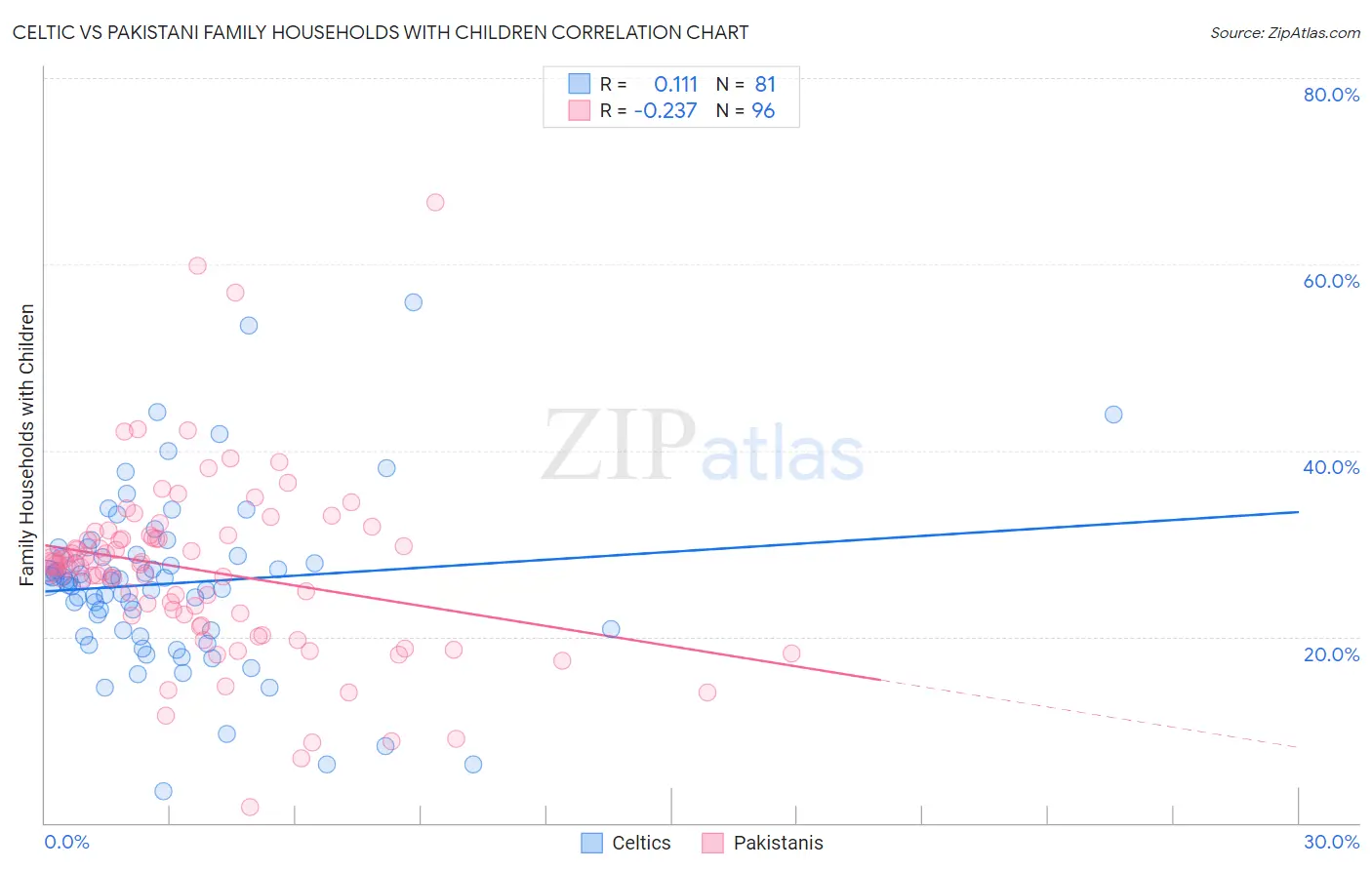Celtic vs Pakistani Family Households with Children
COMPARE
Celtic
Pakistani
Family Households with Children
Family Households with Children Comparison
Celtics
Pakistanis
26.6%
FAMILY HOUSEHOLDS WITH CHILDREN
0.4/ 100
METRIC RATING
277th/ 347
METRIC RANK
27.9%
FAMILY HOUSEHOLDS WITH CHILDREN
96.0/ 100
METRIC RATING
116th/ 347
METRIC RANK
Celtic vs Pakistani Family Households with Children Correlation Chart
The statistical analysis conducted on geographies consisting of 168,845,101 people shows a poor positive correlation between the proportion of Celtics and percentage of family households with children in the United States with a correlation coefficient (R) of 0.111 and weighted average of 26.6%. Similarly, the statistical analysis conducted on geographies consisting of 335,080,458 people shows a weak negative correlation between the proportion of Pakistanis and percentage of family households with children in the United States with a correlation coefficient (R) of -0.237 and weighted average of 27.9%, a difference of 4.9%.

Family Households with Children Correlation Summary
| Measurement | Celtic | Pakistani |
| Minimum | 3.4% | 1.7% |
| Maximum | 55.9% | 66.6% |
| Range | 52.5% | 64.9% |
| Mean | 25.7% | 27.1% |
| Median | 26.1% | 27.7% |
| Interquartile 25% (IQ1) | 20.6% | 21.8% |
| Interquartile 75% (IQ3) | 28.7% | 30.7% |
| Interquartile Range (IQR) | 8.0% | 9.0% |
| Standard Deviation (Sample) | 9.0% | 9.9% |
| Standard Deviation (Population) | 9.0% | 9.9% |
Similar Demographics by Family Households with Children
Demographics Similar to Celtics by Family Households with Children
In terms of family households with children, the demographic groups most similar to Celtics are Immigrants from Europe (26.6%, a difference of 0.060%), Immigrants from Spain (26.6%, a difference of 0.080%), Finnish (26.6%, a difference of 0.080%), Senegalese (26.6%, a difference of 0.10%), and Immigrants from Northern Europe (26.7%, a difference of 0.11%).
| Demographics | Rating | Rank | Family Households with Children |
| Immigrants | Zaire | 0.7 /100 | #270 | Tragic 26.7% |
| French | 0.7 /100 | #271 | Tragic 26.7% |
| Somalis | 0.7 /100 | #272 | Tragic 26.7% |
| Immigrants | Hungary | 0.6 /100 | #273 | Tragic 26.7% |
| Eastern Europeans | 0.6 /100 | #274 | Tragic 26.7% |
| Immigrants | Northern Europe | 0.5 /100 | #275 | Tragic 26.7% |
| Immigrants | Spain | 0.5 /100 | #276 | Tragic 26.6% |
| Celtics | 0.4 /100 | #277 | Tragic 26.6% |
| Immigrants | Europe | 0.4 /100 | #278 | Tragic 26.6% |
| Finns | 0.4 /100 | #279 | Tragic 26.6% |
| Senegalese | 0.4 /100 | #280 | Tragic 26.6% |
| Lithuanians | 0.3 /100 | #281 | Tragic 26.6% |
| French American Indians | 0.3 /100 | #282 | Tragic 26.6% |
| Immigrants | North America | 0.3 /100 | #283 | Tragic 26.6% |
| Immigrants | Canada | 0.3 /100 | #284 | Tragic 26.5% |
Demographics Similar to Pakistanis by Family Households with Children
In terms of family households with children, the demographic groups most similar to Pakistanis are Immigrants from Malaysia (27.9%, a difference of 0.010%), Central American Indian (27.9%, a difference of 0.010%), Zimbabwean (27.9%, a difference of 0.050%), European (27.9%, a difference of 0.080%), and Immigrants from Africa (28.0%, a difference of 0.13%).
| Demographics | Rating | Rank | Family Households with Children |
| Tohono O'odham | 97.6 /100 | #109 | Exceptional 28.0% |
| Spaniards | 97.4 /100 | #110 | Exceptional 28.0% |
| Scandinavians | 97.1 /100 | #111 | Exceptional 28.0% |
| Immigrants | Middle Africa | 97.0 /100 | #112 | Exceptional 28.0% |
| Arabs | 97.0 /100 | #113 | Exceptional 28.0% |
| South American Indians | 96.9 /100 | #114 | Exceptional 28.0% |
| Immigrants | Africa | 96.8 /100 | #115 | Exceptional 28.0% |
| Pakistanis | 96.0 /100 | #116 | Exceptional 27.9% |
| Immigrants | Malaysia | 95.9 /100 | #117 | Exceptional 27.9% |
| Central American Indians | 95.9 /100 | #118 | Exceptional 27.9% |
| Zimbabweans | 95.6 /100 | #119 | Exceptional 27.9% |
| Europeans | 95.4 /100 | #120 | Exceptional 27.9% |
| Immigrants | Western Asia | 93.6 /100 | #121 | Exceptional 27.9% |
| Immigrants | Zimbabwe | 92.8 /100 | #122 | Exceptional 27.8% |
| Immigrants | Northern Africa | 91.8 /100 | #123 | Exceptional 27.8% |